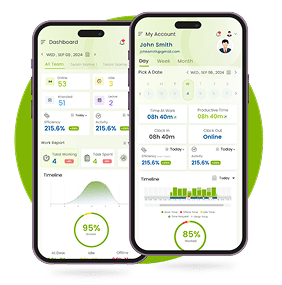We’ve all worked with that one person who’s always busy, yet somehow their tasks pile up and projects lag behind. In the modern workplace, busyness is often mistaken as productivity, but the truth is clear: motion doesn’t equal progress.
The real challenge for business owners, HR leaders, and project managers isn’t tracking activity; it’s identifying which efficiency metrics truly define performance efficiency.
In this blog, you’ll learn the 7 proven efficiency metrics that separate busy work from meaningful output and how time tracking software makes measuring them super easy.
We’ll look at:
What defines real productivity
The key efficiency indicators every manager should track
How to turn time-tracking data into data-driven productivity insights
Why “Busy” Isn’t the Same as “Productive”
The Illusion of Busyness
Multitasking, notifications and endless meetings create a false sense of progress. Many companies still equate work efficiency with hours worked rather than output quality. This results in inflated workloads and declining focus.
The Cost of Measuring Effort Over Impact
Focusing on activity rather than outcomes leads to low ROI, employee burnout, and poor business performance metrics. Real productivity means achieving more with the same or fewer resources.
What Smart Leaders Measure Instead
Instead of tracking just time, high-performing teams measure real efficiency metrics: utilization, focus, completion rates and engagement. These key performance indicators (KPIs) turn vague busyness into actionable performance insights.
7 Proven Indicators of Real Workplace Efficiency
Metric #1 – Utilization Rate
Definition: The percentage of logged hours that are genuinely productive.
Why it matters: Utilization rate is one of the most essential efficiency metrics examples for managers. It helps detect underused talent or overburdened employees, allowing you to balance workloads efficiently.
How Desklog helps: Desklog’s automated time tracking feature automatically separates productive time and focus time from idle time, offering a clear picture of true utilization rates.
Metric #2 – Focus Time Ratio
Definition: Measures how much time employees spend in distraction-free deep work.
Why it matters: A higher focus ratio indicates fewer context switches, higher accuracy and better employee performance efficiency.
How Desklog helps: Desklog tracks workflow efficiency measures by analyzing how deeply an employee is focused on their work by giving real-time focus insights that support performance benchmarking.
Metric #3 – Task Completion Efficiency
Definition: The ratio of tasks completed to tasks assigned within a given time frame.
Why it matters: This metric highlights overall workflow consistency and reliability. Steady completion rates reflect solid team efficiency metrics and well-managed project execution.
How Desklog helps: With its dedicated project tracking feature, Desklog delivers accurate, real-time visibility into task completion and project flow, turning productivity data into actionable insights.
Metric #4 – Output Quality Index
Definition: A measure that balances speed with accuracy and quality.
Why it matters: High-quality output ensures that productivity doesn’t come at the cost of rework or client dissatisfaction, key for business performance metrics in service-oriented industries.
Metric #5 – Project Predictability
Definition: The ratio of planned vs. actual time spent on tasks or projects.
Why it matters: This key efficiency indicator reflects how accurately teams estimate and deliver work, vital for project efficiency KPIs in large organizations.
How Desklog helps: Desklog automatically compares expected time against real tracked time, producing performance efficiency metrics that improve project forecasting and resource planning.
Metric #6 – Employee Engagement Score
Definition: A holistic measure combining active work time, breaks, and wellness indicators.
Why it matters: Sustainable productivity depends on balance. Overworked teams burn out, while disengaged ones underperform. Engagement drives team efficiency and retention.
How Desklog helps: Desklog promotes balanced work rhythms through its dedicated wellness module, which sends wellness reminders at set intervals to encourage ethical breaks and sustain focus. This promotes long-term employee performance efficiency and overall well-being.
Metric #7 – Efficiency Trend Over Time
Definition: Tracks changes in productivity month-over-month.
Why it matters: Trends highlight improvement or decline across teams and departments, helping managers spot long-term opportunities for workflow efficiency measures and training needs.
How Desklog helps: Desklog’s Insights feature visualizes efficiency and performance trends, giving HR leaders and executives a bird’s-eye view of how to define real efficiency in business.
Turning Insights Into Impact: How Managers Use Metrics That Matter
Use Metrics for Coaching, Not Control
Transparency builds trust. By using these metrics for feedback and mentoring instead of micromanagement, you empower employees to self-correct and grow.
Create Balanced KPIs That Support Wellness
Smart companies link productivity KPIs with engagement data, building an environment where efficiency doesn’t sacrifice health.
Align Metrics with Business Goals
When efficiency measurement tools align with company objectives (like revenue growth or client satisfaction), data becomes a driver of growth and success, not just a report.
Why Desklog Is the Smartest Way to Measure Real Efficiency
Unlike generic time trackers, Desklog goes beyond surface-level analytics. It ties employee productivity metrics directly to real business outcomes, bridging the gap between time logged and value delivered.
Unified Dashboard for All Metrics
All 7 KPIs- utilization, focus, completion, quality, predictability, engagement and trend- are visualized in one place. No spreadsheets. Just clarity.
Real-Time Reports for Managers and HR
Desklog changes raw data into performance insights, empowering leaders to identify patterns, optimize workflows and make smarter staffing decisions.
Culture-First, Not Control-First
Built with transparency and privacy in mind, Desklog encourages data-based productivity while respecting personal boundaries.
Final Thoughts:
True efficiency comes from understanding which metrics matter, tracking them consistently, and using the insights to make smarter, data-driven decisions.
By focusing on the 7 proven efficiency metrics, leaders can move beyond surface-level activity and identify what truly improves performance. When applied thoughtfully, these metrics empower teams to improve workflow efficiency, maintain employee well-being and achieve business goals more predictably.
FAQ
1What are the most important employee productivity metrics?
Utilization rate, focus time, task completion efficiency, output quality, project predictability, engagement, and trend analysis.
2How can I measure real efficiency in the workplace?
Use efficiency measurement tools like Desklog to connect time data with performance outcomes.
3What’s the difference between busyness and productivity?
Busyness measures activity; productivity measures meaningful output and results.
4How does Desklog help track efficiency metrics?
Desklog automates tracking across all key performance indicators (KPIs) and visualizes trends for informed decision-making.
5Can Desklog measure productivity quality, not just time?
Yes. It analyzes rework rates, focus data, and project outcomes to ensure performance efficiency metrics reflect quality as well as quantity.
6What is the Focus Time Ratio and why does it matter?
Focus Time Ratio measures how much time employees spend in uninterrupted, deep work. Higher focus time leads to better output quality, fewer errors, and improved overall productivity.
7How do Task Completion Efficiency metrics improve team performance?
By tracking the ratio of tasks completed versus tasks assigned, managers can identify bottlenecks, improve workflow efficiency, and ensure consistent project execution.
8What role does Employee Engagement Score play in real efficiency?
Engagement scores combine active work, breaks, and wellness indicators. Maintaining balanced engagement prevents burnout, increases retention, and promotes sustainable productivity.

















